
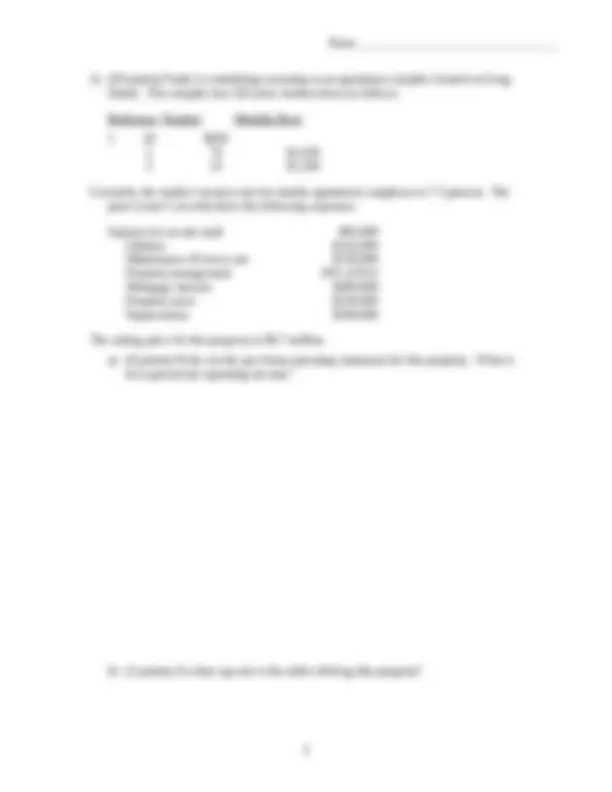
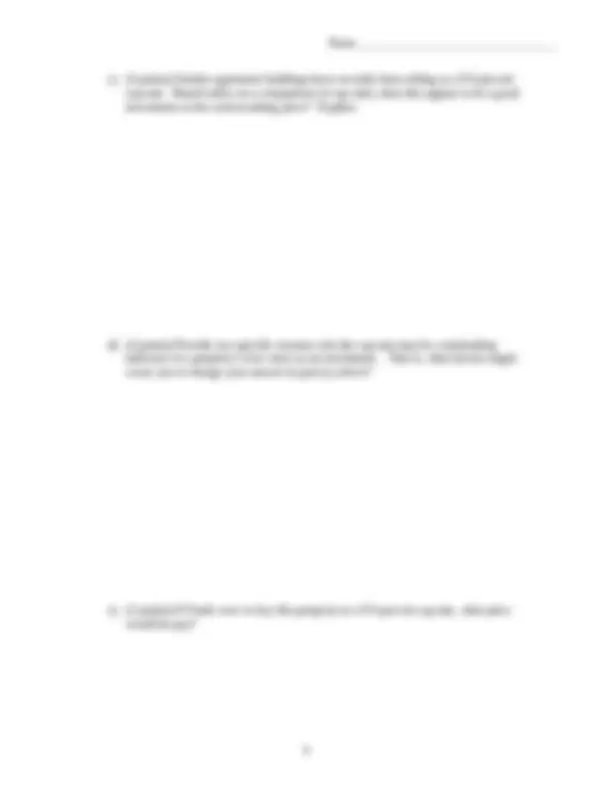
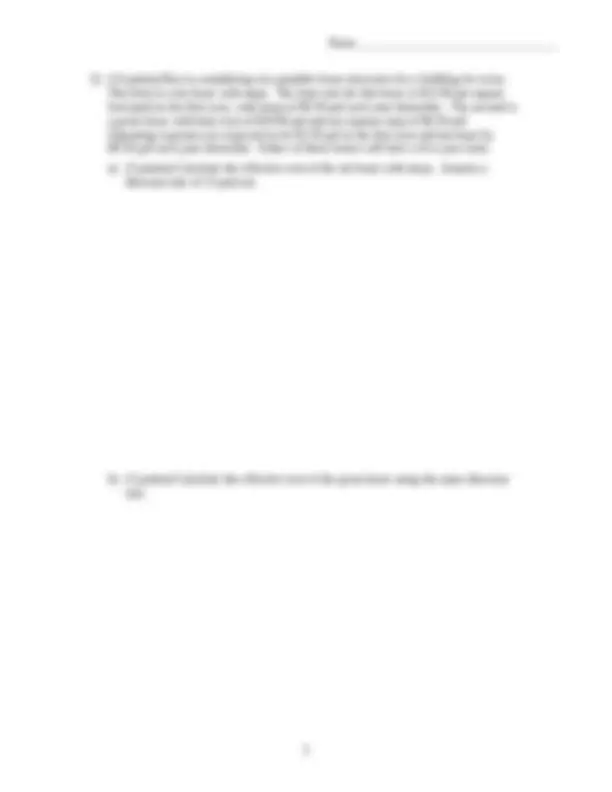
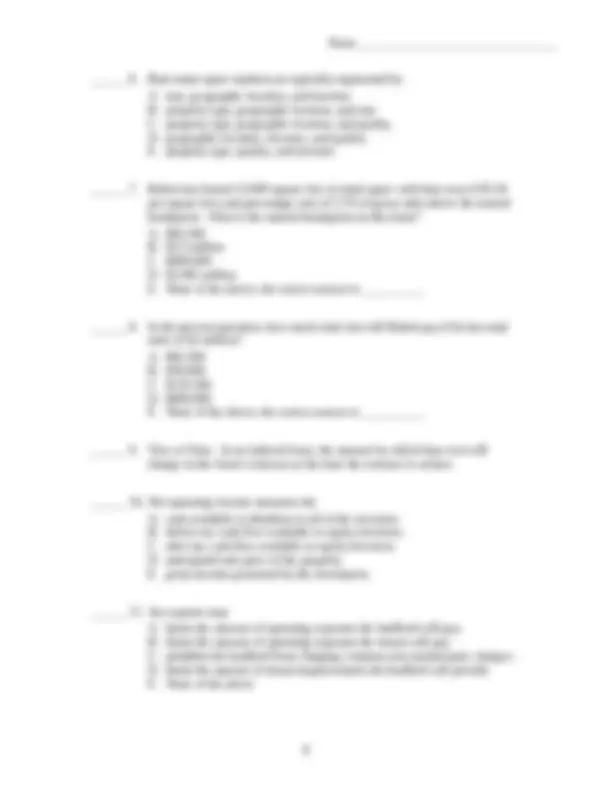
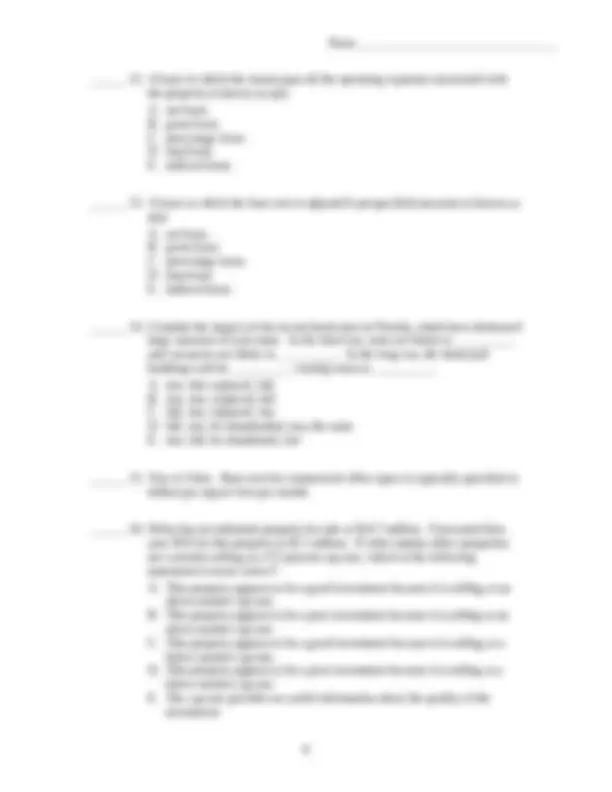
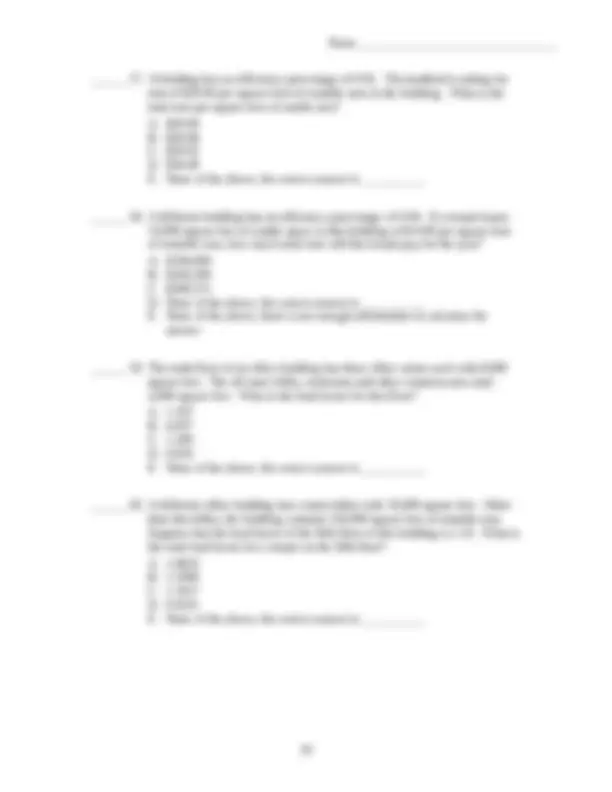


Study with the several resources on Docsity

Earn points by helping other students or get them with a premium plan


Prepare for your exams
Study with the several resources on Docsity

Earn points to download
Earn points by helping other students or get them with a premium plan
Community
Ask the community for help and clear up your study doubts
Discover the best universities in your country according to Docsity users
Free resources
Download our free guides on studying techniques, anxiety management strategies, and thesis advice from Docsity tutors
Material Type: Exam; Professor: Longhofer; Class: Real Estate Investment Analy; Subject: Real Estate; University: Wichita State University; Term: Fall 2004;
Typology: Exams
1 / 12

This page cannot be seen from the preview
Don't miss anything!







Fall 2004 Midterm Exam 1 Version A Dr. Stanley D. Longhofer MW 9:30-10: You have 1 hour and 15 minutes to complete this exam. I know its long; don’t worry, just do the best you can in the time allotted. I would spend a few minutes looking it over before you begin; start with the questions you know best and work on the others last. The number of points for each question is intended to indicate how much time you should spend on each. This weighting incorporates both the time it should take you to answer the question and its relative importance. I’ve tried to eliminate any ambiguity about how to interpret the questions on the exam. Nevertheless, if you make any assumptions not explicitly stated in the questions, make sure you write them down so I can see what you are doing. Finally, remember to show your work. I can only give partial credit for incorrect answers if I can tell what you were trying to do.
b) (5 points) Calculate the current market value of this property assuming that its reversion value will be based on a 4 percent increase in market value per year. c) (2 points) If she pays this price, what is Amy’s going-in cap rate?
c) (4 points) Similar apartment buildings have recently been selling at a 9.0 percent cap rate. Based solely on a comparison of cap rates, does this appear to be a good investment at the current asking price? Explain. d) (4 points) Provide two specific reasons why the cap rate may be a misleading indicator of a property’s true value as an investment. That is, what factors might cause you to change your answer in part (c) above? e) (2 points) If Frank were to buy this property at a 9.0 percent cap rate, what price would he pay?
Use the following information to answer the next four questions. Ally would like to purchase a shopping center property. She has determined that the current market vacancy rate is 6 percent, and that operating expenses will run at about 10 percent of effective gross income. The prevailing market cap rate is 9 percent. The first shopping center she has analyzed has 35,000 square feet which rents at $15.50 per square foot. The second shopping center she is considering 40,000 square feet and rents for $14.00 per square foot. ______ 2. Effective gross income for the first center is A. $542,500. B. $509,950. C. $32,550. D. $458,955. E. None of the above; the correct answer is __________. ______ 3. Net operating income for the first center is A. $542,500. B. $509,950. C. $32,550. D. $458,955. E. None of the above; the correct answer is __________. ______ 4. Based on the current market cap rate, the market value of second center is A. $6.222 million. B. $5.264 million. C. $473,760. D. $4.264 million. E. None of the above; the correct answer is __________. ______ 5. A third shopping center is available for purchase at an 8.50 percent cap rate. Under what circumstances might this be a good investment? More than one answer may be correct; write down all correct answers. A. The income of this center is expected to grow at a faster rate in the future than other centers in the market. B. This income from this center is expected to grow at a slower rate in the future than other centers in the market. C. Allie has a lower required rate of return than other investors in the market. D. Estimates of future income for this center are less certain than they are for other centers in the market. E. Allie has a higher required rate of return than other investors in the market.
______ 6. Real estate space markets are typically segmented by A. size, geographic location, and investor. B. property type, geographic location, and size. C. property type, geographic location, and quality. D. geographic location, investor, and quality. E. property type, quality, and investor. ______ 7. Robert has leased 15,000 square feet of retail space with base rent of $5. per square foot and percentage rent of 2.5% of gross sales above the natural breakpoint. What is the natural breakpoint on this lease? A. $82, B. $3.3 million C. $600, D. $2.062 million E. None of the above; the correct answer is __________. ______ 8. In the prevous question, how much total rent will Robert pay if he has total sales of $2 million? A. $82, B. $50, C. $132, D. $600, E. None of the above; the correct answer is __________. ______ 9. True or False: In an indexed lease, the amount by which base rent will change in the future is known at the time the contract is written. ______ 10. Net operating income measures the A. cash available to distribute to all of the investors. B. before-tax cash flow available to equity investors. C. after-tax cash flow available to equity investors. D. anticipated sale price of the property. E. gross income generated by the investment. ______ 11. An expense stop A. limits the amount of operating expenses the landlord will pay. B. limits the amount of operating expenses the tenant will pay. C. prohibits the landlord from charging common area maintenance charges. D. limits the amount of tenant improvements the landlord will provide. E. None of the above
______ 17. A building has an efficiency percentage of 0.92. The landlord is asking for rent of $29.00 per square foot of rentable area in the building. What is the total rent per square foot of usable area? A. $29. B. $26. C. $29. D. $30. E. None of the above; the correct answer is __________. ______ 18. A different building has an efficiency percentage of 0.94. If a tenant leases 14,000 square feet of usable space in this building at $14.00 per square foot of rentable area, how much total rent will that tenant pay for the year? A. $196, B. $184, C. $208, D. None of the above; the correct answer is __________. E. None of the above; there is not enough information to calculate the answer. ______ 19. The tenth floor of an office building has three office suites each with 8, square feet. The elevator lobby, restrooms and other common area total 4,000 square feet. What is the load factor for this floor? A. 1. B. 0. C. 1. D. 0. E. None of the above; the correct answer is __________. ______ 20. A different office building has a main lobby with 10,000 square feet. Other than this lobby, the building contains 120,000 square feet of rentable area. Suppose that the load factor of the fifth floor of this building is 1.10. What is the total load factor for a tenant on the fifth floor? A. 1. B. 1. C. 1. D. 0. E. None of the above; the correct answer is __________.
______ 21. True or False: The fixed location of real estate is its most important physical characteristics, because many of its other characteristics are derived from its fixed location. Use the following pro forma to answer the next four questions. Potential gross income $1,700, Vacancy & collections 255, Effective gross income 1,445, Operating expenses 794, Net operating income 650, This property has a market value of $5.65 million. ______ 22. What vacancy allowance is used in this statement? A. 38.25% B. 85.00% C. 10.00% D. 55.00% E. None of the above; the correct answer is 15.00%. ______ 23. What is this property’s cap rate? A. 8.69% B. 3.91% C. 10.00% D. 11.51% E. None of the above; the correct answer is __________. ______ 24. What is the gross income multiplier for this property? A. 8. B. 3. C. 10. D. 11. E. None of the above; the correct answer is __________. ______ 25. What is the net income multiplier for this property? A. 8. B. 3. C. 10. D. 11. E. None of the above; the correct answer is __________.